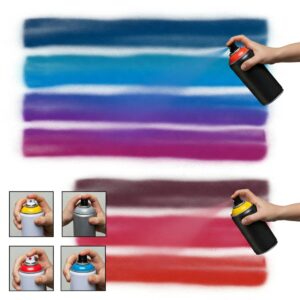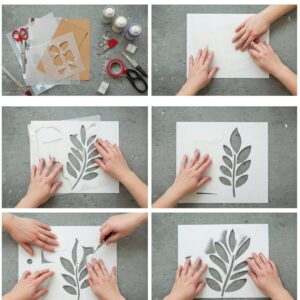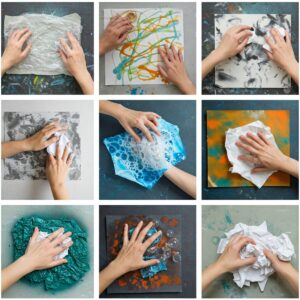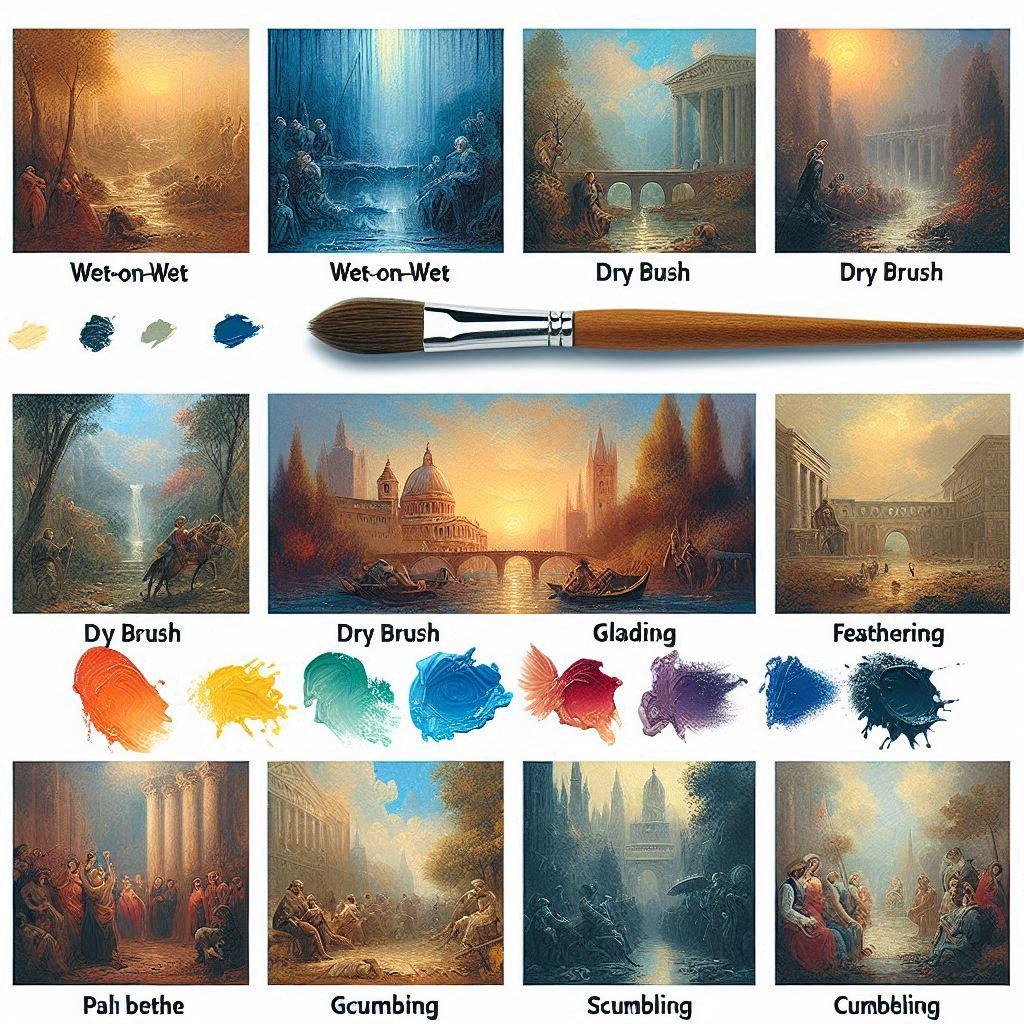Spray paint art techniques have evolved far beyond just tagging walls. Today, aerosol art has become a respected form of creative expression that allows artists to create stunning pieces with depth, texture, and vibrant colors. Whether you’re looking to create cosmic space scenes, detailed stencil art, or dynamic abstract pieces, learning the fundamental spray paint art techniques will help you transform a simple can of paint into a versatile artistic tool. This guide will take you beyond basic tagging to explore techniques that beginners can master with practice and patience.

Key Points:
- Learn proper can control and distance techniques
- Discover blending, layering, and texturing methods
- Explore stenciling for precise details
- Master specialized techniques like space painting
- Understand safety and legal considerations
Essential Spray Paint Art Techniques Every Beginner Should Know
The journey into spray paint art starts with understanding how to control your medium. Unlike traditional paintbrushes, spray cans create effects through pressure, distance, and movement. The most fundamental spray paint art techniques involve learning to control these variables to achieve different effects.
Supplies You’ll Need to Get Started
Before diving into techniques, gathering the right supplies is crucial for success:
| Supply | Purpose | Recommendation for Beginners |
|---|---|---|
| Spray Paint | Your primary medium | Montana Gold, MTN 94, or Rustoleum |
| Surfaces | Canvas, wood, or paper | Primed canvas or smooth boards |
| Masks/Respirators | Protect your lungs | N95 or painting respirator |
| Gloves | Protect your hands | Nitrile gloves |
| Caps/Nozzles | Control spray pattern | Fat caps for fills, skinny caps for details |
| Stencil Materials | Create precise shapes | Acetate sheets or cardboard |
| Complementary Tools | Add details | Posca markers, sponges, cards |
Safety should always come first when working with spray paint. Always work in well-ventilated areas, preferably outdoors, and use proper respiratory protection. Your artistic journey shouldn’t come at the expense of your health.
Mastering Basic Control Techniques

The foundation of all spray paint art is learning to control your can. Practice these fundamental techniques:
- Distance Control: The distance between your can and surface dramatically affects your results:
- Close (1-3 inches): Creates tight, concentrated lines
- Medium (5-10 inches): Produces even coverage
- Far (12+ inches): Creates soft, diffused effects
- Movement Speed: How quickly you move the can affects paint density:
- Slow movement: Creates heavy coverage and potential drips
- Medium speed: Provides even application
- Fast movement: Creates light, misty effects
- Consistent Pressure: Press the nozzle completely down for an even spray rather than halfway, which can create sputtering effects (unless that’s your intention).
Creating Depth Through Blending and Layering
Once you’ve mastered basic control, you can move on to more advanced spray paint art techniques that create depth and dimension.
Color Blending Methods
Blending colors is where spray paint truly shines as a medium. To create smooth transitions between colors:
- Apply your first color in a gradient, gradually fading out
- While still wet, apply the second color where the first begins to fade
- Use light, sweeping motions to softly overlap the colors
- Work quickly before the first color dries completely
For beginners, practicing with complementary colors (like blue and orange or purple and yellow) makes it easier to see how the blends work. Many street artists use this technique to create vibrant backgrounds or smooth color transitions in their pieces.
Layering for Dimension
Layering involves building up your artwork in stages:
- Start with your background colors
- Add middle-ground elements
- Finish with foreground details
Allow each layer to dry before adding the next to prevent colors from mixing unintentionally. This technique creates true depth in your artwork and is commonly used by artists like Banksy to create multi-dimensional pieces.
Stencil Techniques for Precise Details
Stenciling is perhaps the most accessible spray paint art technique for beginners to create precise, repeatable designs.
Creating Effective Stencils
Your stencil material and design are crucial for good results:

- Use sturdy materials like acetate sheets, cardboard, or adhesive vinyl
- Ensure your design has bridges to keep floating pieces connected
- Cut cleanly with a sharp X-acto knife or stencil cutter
- Consider multiple layer stencils for complex designs with different colors
Applying Stencils Like a Pro
- Secure your stencil firmly to prevent paint seeping underneath
- Hold the can 6-8 inches away for best results
- Apply light, even coats rather than one heavy coat
- Remove the stencil carefully while the paint is still slightly wet
Many famous street artists like Shepard Fairey built their careers on mastering stencil techniques to create iconic images with spray paint.

Texturing Methods for Unique Effects
Adding texture to your spray paint art creates visual interest and uniqueness. Try these beginner-friendly texturing techniques:
- Plastic Wrap: Press crumpled plastic onto wet paint and remove for a marbled effect
- Salt Sprinkle: Sprinkle salt on wet paint to create a speckled texture
- Cardboard Dabbing: Use torn cardboard edges to create rough textures
- Sponge Techniques: Dab with a sponge for organic, natural-looking textures
Space and Galaxy Painting Techniques

One of the most popular styles in spray paint art is creating space scenes. This specialized technique creates stunning cosmic landscapes with relatively simple methods.
Basic Space Scene Steps
- Create a black or dark blue background
- Use a toothbrush to flick white paint for distant stars
- Use round objects (like cups) as masks for planets
- Create nebulae with light, sweeping sprays of vibrant colors
- Add highlights with white paint to create depth and light sources
Check out this video tutorial on creating scenes with spray paint:
Protecting and Preserving Your Art
After creating your masterpiece, protecting it ensures longevity:
- Allow your painting to dry completely (24-48 hours)
- Apply a clear protective coating designed for aerosol art
- Store artwork away from direct sunlight to prevent fading
- If displaying outdoors, use UV-resistant clear coats
For canvas works, Krylon’s UV-resistant clear coat is an excellent choice to seal and protect your artwork from the elements and fading.
Legal and Safe Places to Practice
Finding legal spaces to practice is essential for developing your skills responsibly:
- Personal property or purchased canvases
- Community arts programs and designated graffiti walls
- Local art groups that organize spray paint events
- Commercially available practice boards
Many cities now host street art festivals where beginners can learn techniques from established artists in a supportive environment.
Troubleshooting Common Issues
Even experienced artists encounter problems. Here’s how to fix common issues:
- Drips and Runs: Let dry completely, sand lightly, then paint over
- Clogged Nozzles: Soak in warm water or replace with new caps
- Uneven Coverage: Apply multiple light coats rather than one heavy coat
- Bleeding Under Stencils: Use spray adhesive or tape to secure edges better
Project Ideas to Practice Your Skills
Start with these beginner-friendly projects to build confidence:
- Abstract gradient backgrounds
- Simple planet and space scenes
- Single-layer stencil designs
- Textured effect samples
- Silhouette landscapes against colorful backgrounds
Like any art form, mastering spray paint art techniques requires practice. Don’t be discouraged by early results—keep experimenting and refining your skills. Many successful street artists spent years perfecting their techniques before developing their signature styles.
Bringing It All Together: Your First Complete Piece
Once you’ve practiced individual spray paint art techniques, combine them in a full piece:
- Plan your composition first on paper
- Prepare your surface with a base coat if needed
- Work in layers, from background to foreground
- Allow proper drying time between techniques
- Add final details with complementary tools like Posca markers
- Protect your finished work with clear coat
Remember that spray paint art should be fun and expressive. Don’t worry about perfection—embrace happy accidents and learn from each piece you create.
Spray paint art techniques offer endless creative possibilities that go far beyond simple tagging. By mastering control, blending, stenciling, and texturing methods, beginners can create impressive artwork with just a few cans of paint. The key is consistent practice and willingness to experiment. Start with basic techniques, then gradually incorporate more advanced methods as your confidence grows. Before long, you’ll develop your own unique style and approach to this versatile and dynamic art form.
FAQ About Spray Paint Art Techniques
How long does spray paint take to dry on canvas?
Spray paint typically takes 15-30 minutes to be touch dry on canvas, but allow 24 hours for it to cure completely before applying protective coatings or additional techniques.
What protective coating should I use on spray paint art?
For best results, use a clear acrylic spray designed specifically for artwork protection, such as Krylon Clear Coat or Montana Clear Varnish. These products protect against UV damage and moisture without yellowing over time.
Can you make money selling spray paint art?
Yes, many artists sell spray paint art through local art markets, online platforms like Etsy, or by doing live demonstrations at events. Space paintings and customized stencil art are particularly popular with buyers.
Is spray paint art illegal?
Spray paint art itself is legal when created on your own property, purchased canvases, or in designated areas with permission. However, painting on public or private property without permission is illegal vandalism.
What surfaces work best for spray paint art?
Smooth, primed canvases, wood panels, metal, and specialized papers work best for spray paint art. For beginners, canvas and smooth cardboard are affordable and forgiving surfaces to practice on.
How do I fix spray paint mistakes?
For minor mistakes, wait until the paint dries and paint over them. For major issues, sand the area lightly once completely dry, then reapply paint in thin, even coats. On canvas, you may need to apply a primer before repainting.



